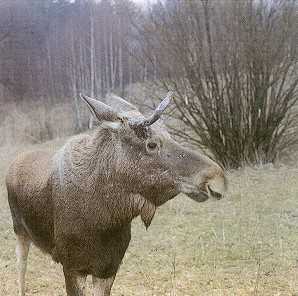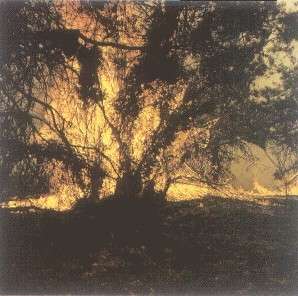Threats to Forests
![]()
 For a long time
forest husbandry has been experiencing production cycle interruptions
such as massive occurrences of insect pests. These often reach
the SIZE of severe gradations. Occasionally there are the outbreaks
of fungal diseases, often permanent and wide reaching. Sometimes
these interruptions are caused by climatic and natural disasters
- blowdown of trees, snowbreaks, droughts and frosts. The effects
of the largest gradation of the nun moth in the history of European
forestry, which occurred in years 1978 to 1984 and affected about
one-third of the forests in Poland are experienced to this day.
The massive outbreaks of Zeiraphera griseana in spruce forests
of the Sudeten Mountains and of Ezetria buoliana in the Swietokrzyskie
Mountains were equally dangerous. In 1991 massive outbreaks of
such insects as: the pine sawfly, the pine beauty, Bupalus piniarius
and pine webworm were a tHReat. In tree plantations Hubbins abietis
and zakorki caused a lot of damage. Especially dangerous in situations
of interrupting ecological processes are secondary pests. These
pests are insects that finish off weak trees such as bark beetles,
borers, przyplaszczki. To a large extent they determine the amount
of dead trees in a forest (so-called deadwood). In the years 1981-1990,
98.8 million m> dead trees were removed from forests. This
is ten times more than the amount of deadwood that would result
from a natural process of tree competition with other plants and
diversification structure of tree stand.
For a long time
forest husbandry has been experiencing production cycle interruptions
such as massive occurrences of insect pests. These often reach
the SIZE of severe gradations. Occasionally there are the outbreaks
of fungal diseases, often permanent and wide reaching. Sometimes
these interruptions are caused by climatic and natural disasters
- blowdown of trees, snowbreaks, droughts and frosts. The effects
of the largest gradation of the nun moth in the history of European
forestry, which occurred in years 1978 to 1984 and affected about
one-third of the forests in Poland are experienced to this day.
The massive outbreaks of Zeiraphera griseana in spruce forests
of the Sudeten Mountains and of Ezetria buoliana in the Swietokrzyskie
Mountains were equally dangerous. In 1991 massive outbreaks of
such insects as: the pine sawfly, the pine beauty, Bupalus piniarius
and pine webworm were a tHReat. In tree plantations Hubbins abietis
and zakorki caused a lot of damage. Especially dangerous in situations
of interrupting ecological processes are secondary pests. These
pests are insects that finish off weak trees such as bark beetles,
borers, przyplaszczki. To a large extent they determine the amount
of dead trees in a forest (so-called deadwood). In the years 1981-1990,
98.8 million m> dead trees were removed from forests. This
is ten times more than the amount of deadwood that would result
from a natural process of tree competition with other plants and
diversification structure of tree stand.
Fungal diseases strongly influence the health of forests, causing mainly diseases of the root systems, which occur on an area of about 400,000 hectares. More than ever damages are caused by leaf and needle diseases as well as ailments of the offshoots.
More often, game animals are becoming a tHReat to plantations and young tree stands, although these animals are, after all, a natural component of the forest biocenoses. The amount of eaten or trampled plantations and young tree stands with bark eaten off and broken by deer or moose measured 390,000 hectares in 1991. In these areas it was impossible to achieve tree breeding goals.
In 1992 there were tHRee times more forests fires than
in the preceding years and they burned an area that was twelve
times larger (37,00 ha). Undoubtedly a factor that caused the
high fire hazard was the long-lasting lack of rain and high air
temperatures. However this does not explain the fire dynamics
of 1992 which were extraordinary in our area. We are led to think
that in many forest regions of Poland, especially in the south
and west, we have to do with a new category of fire hazard. This
new category is a result of coexistence of at least tHRee reinforcing
phenomena: prolonged  drought (perhaps resulting from global climate changes), the effects
of air pollution (the dieback of trees, thinning of tree stands,
rampant growth of grasses, and accumulation of large amounts of
combustible material) and the increased flow of transportation
and tourist traffic going tHRough the forests.
drought (perhaps resulting from global climate changes), the effects
of air pollution (the dieback of trees, thinning of tree stands,
rampant growth of grasses, and accumulation of large amounts of
combustible material) and the increased flow of transportation
and tourist traffic going tHRough the forests.
From the above, it follows that the positive changes which occurred
in Polish forestry, for example, the increase in woodiness, larger
share of deciduous trees, the increase in timber stock the average
amount of timber per hectare, the raising of the average tree
age as well as the positive changes in the utilization of forests,
did not stop the degradation processes. (In 1995 there were less
forests fires and they burned an area 5,306 ha).
The condition of Polish forests is more physically affected by phenomena occurring outside of them and outside of forestry. New sources of tHReats have showed up that are independent of the degree of ecological deformation and methods of forest husbandry. These tHReats are industrial pollution of air and soil, water deficit and pollution, global climatic changes, damage to the ozone layer and radiation contamination. These tHReats, especially the pollution of the atmosphere by sulphur dioxide and nitrogen oxides are more dangerous than the hazards that have existed up till now. They are reshaping the health condition of forests. They set in motion phenomena whose limits, effects and character we do not yet know.
It is certain that we are now dealing with damages to the fundamental life functions of trees, such as photosynthesis, respiration, transpiration, nutrient intake by the roots and the mechanisms of nutrient transport. Thus the process of autotrophy of producer plants, which is the basis of the proper functioning of nature, is destroyed. As a result of this, the growth is stopped, trees are stunted or simply wither away. Some of the more sensitive species of undergrowth disappear as well as fauna and some microorganisms favourable to the health of forests. Serious soil transformations take place. The species composition of forests is simplified, food-chains of particular groups of organisms are broken and regulatory functions of forest biocenoses cease.
Observations of the condition of forests that began at
the end of the 1970ís show:
ñ an increase in the activity not only of well known insect
pests and fungal diseases but also of organisms that have been
of secondary and tertiary significance up till now, for example
harassing pests and weaknening pathogens (in total about 50 species
of insects and 30 species of fungi);
ñ a disappearance of certain symbiotic fungi that existed
in the environment, and impoverishment and morphological and anatomical
changes of mycorrhyza;
ñ structural changes of plant tissues, including anatomical
changes of the wood;
ñ an increase in the quantity of deadwood, which clearly
shows the intensification of secondary pest activity. This leads
to thinning of tree stands and to pathological deforestation;
ñ the worsening of health conditions of deciduous species
of trees, especially oak and beech, which up till now have been
considered to be the most resistant species;
ñ chemical damages to the soil and root systems, especially
the increase in acidity and contamination by heavy metals, which
speeds up and worsens the degradation of habitats.
 Direct effects of
forest damages due to strong grazing by insects, fires or wind
is immediately visible. In fact, they do not determine the actual
aftermath of these phenomena. Indirect effects last for decades
and can show up in forms of changes that are not easy to attribute
to the actual, primary reasons. This is why it is very hard to
diagnose the health condition of forests. The natural oscillations
of the physio-logical condition of trees and the changes that
accompany them may be judged to be a disease, while the beginnings
of a sickness may show up as an improvement of the appearance
of trees or even increased growth (as a result of "fertilizing"
by airborne nitrogen compounds).
Direct effects of
forest damages due to strong grazing by insects, fires or wind
is immediately visible. In fact, they do not determine the actual
aftermath of these phenomena. Indirect effects last for decades
and can show up in forms of changes that are not easy to attribute
to the actual, primary reasons. This is why it is very hard to
diagnose the health condition of forests. The natural oscillations
of the physio-logical condition of trees and the changes that
accompany them may be judged to be a disease, while the beginnings
of a sickness may show up as an improvement of the appearance
of trees or even increased growth (as a result of "fertilizing"
by airborne nitrogen compounds).
Evaluation of forest conditions has become even more difficult and complicated when forests began to be affected by opposite forces: the increase in SO2 concentration slows photosynthesis, while the increase in CO2 speeds it up; the increase of the amount of nitrogen oxides in the air "fertilizes" trees but at the same time tHRough processes of photorespiration nitrogen oxides cause an increase in the concentration of harmful ozone. Some forests are dangeorously thin. A reforestation indicator for 20% of the Polish forests is below 0.6 while the proper measurement is almost 1.0.
The decrease in the number of trees per unit of forest area resulting from the dieback of the weakest trees causes the reduction of tree crown density. Almost half of the forests have low crown density. There are even cases of large breaks in the crowns. This means that there is no protective ceiling of tree crowns, which exposes the interior of the forest to many external influences. The thinning of tree stands leads to fundamental changes in the basic physical parameters of the forest environment. The affected parameters include the lighting, moisture and heat conditions, the nutrient content and availability in the soil as well as the content of other elements and toxic compounds in the soil. The microclimate of forests is changing as are the trophic conditions. As a result changes in the direction of ecological succession occur. Sometimes after a dieback of forests the succession retreats to the stage of annual weeds and short-lived grasses.